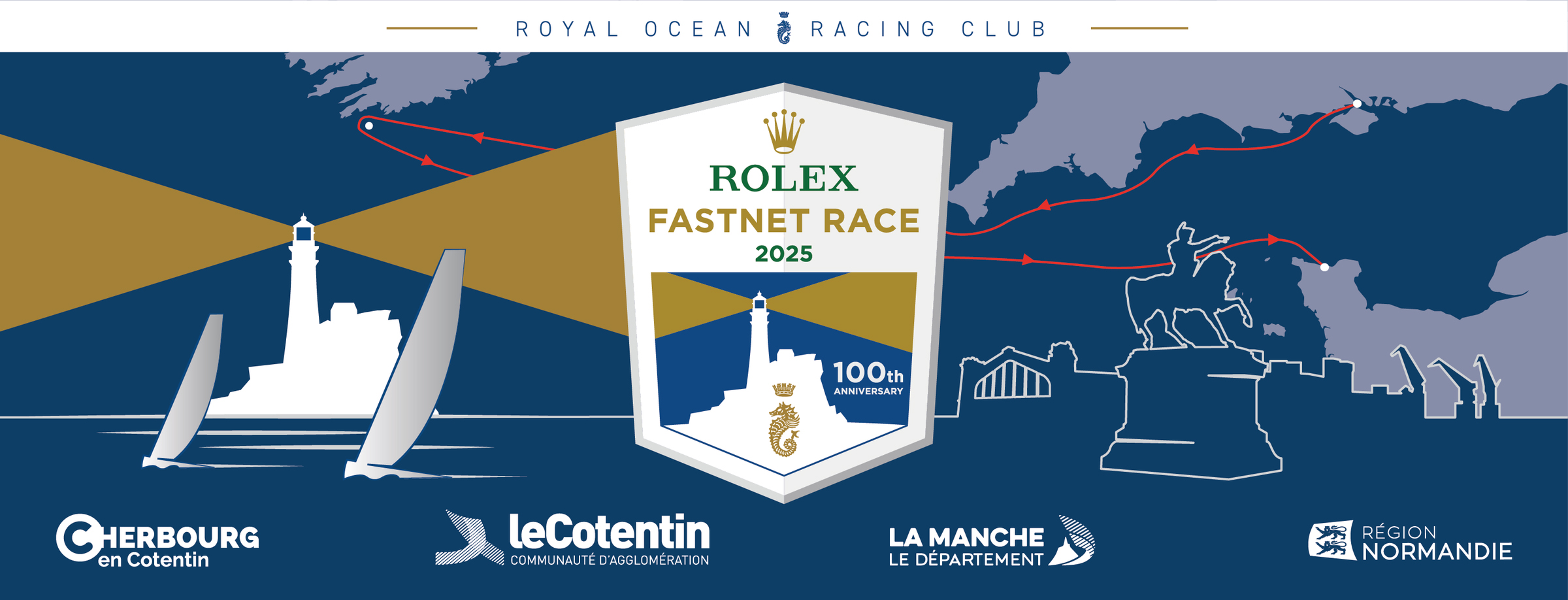Cherbourg-en-Contentin, France: 16:00 Monday 28 July 2025
IRC Super Zero: Three-Way Battle for Monohull Line Honours
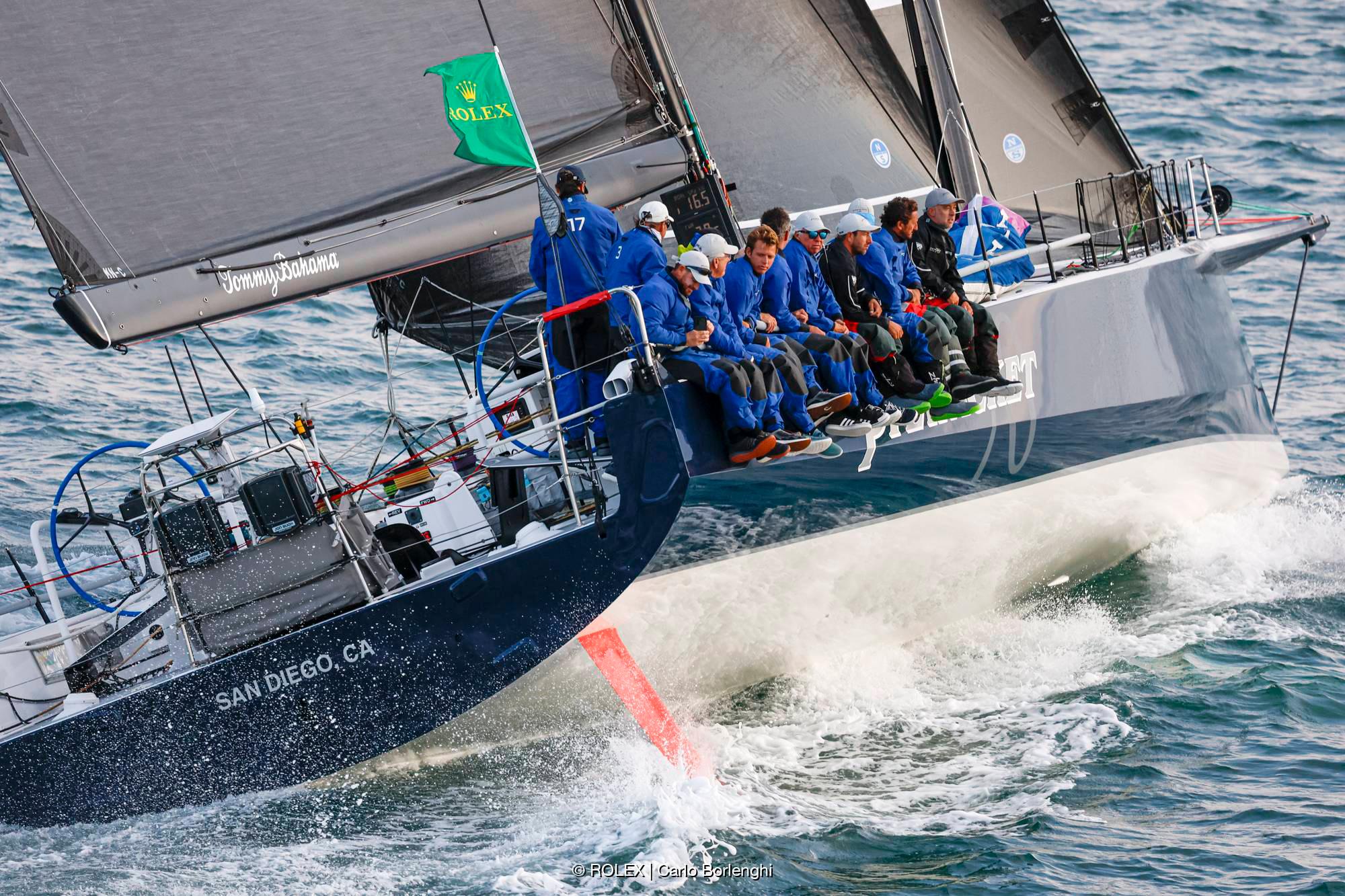 Pyewacket heading to the Rock © ROLEX/Carlo Borlenghi
Pyewacket heading to the Rock © ROLEX/Carlo Borlenghi
Rounding the Fastnet Rock is a bucket list moment for any sailor, but returning to the site of a near-death experience is another matter. Peter Isler, navigator on the 70ft Maxi-sled Pyewacket 70 approached the Rock with mixed feelings last night.
“I had a bit of a moment to reflect on some personal Fastnet history as we approached the Rock a bit after midnight,” said Isler, a veteran of many big offshore classics as well as America’s Cup. “This is my first Fastnet since 2011 when we broke the keel off of the Rambler 100 and were rescued by the RNLI and made an unscheduled stop in Baltimore, Ireland - sans boat.
“When I went up on deck to prepare for the rounding, I made doubly sure I knew where the activation handle was on my life jacket and clipped my crotch strap in place, just in case lightning were to strike twice. Of course it was an uneventful rounding, save for an amazing dolphin show - playing around our canting keel and bulb and making the most of the luminescence in the water to paint aquatic vapour trails all around the boat. It lasted for about an hour and helped keep my mind off of my last Fastnet rounding.”
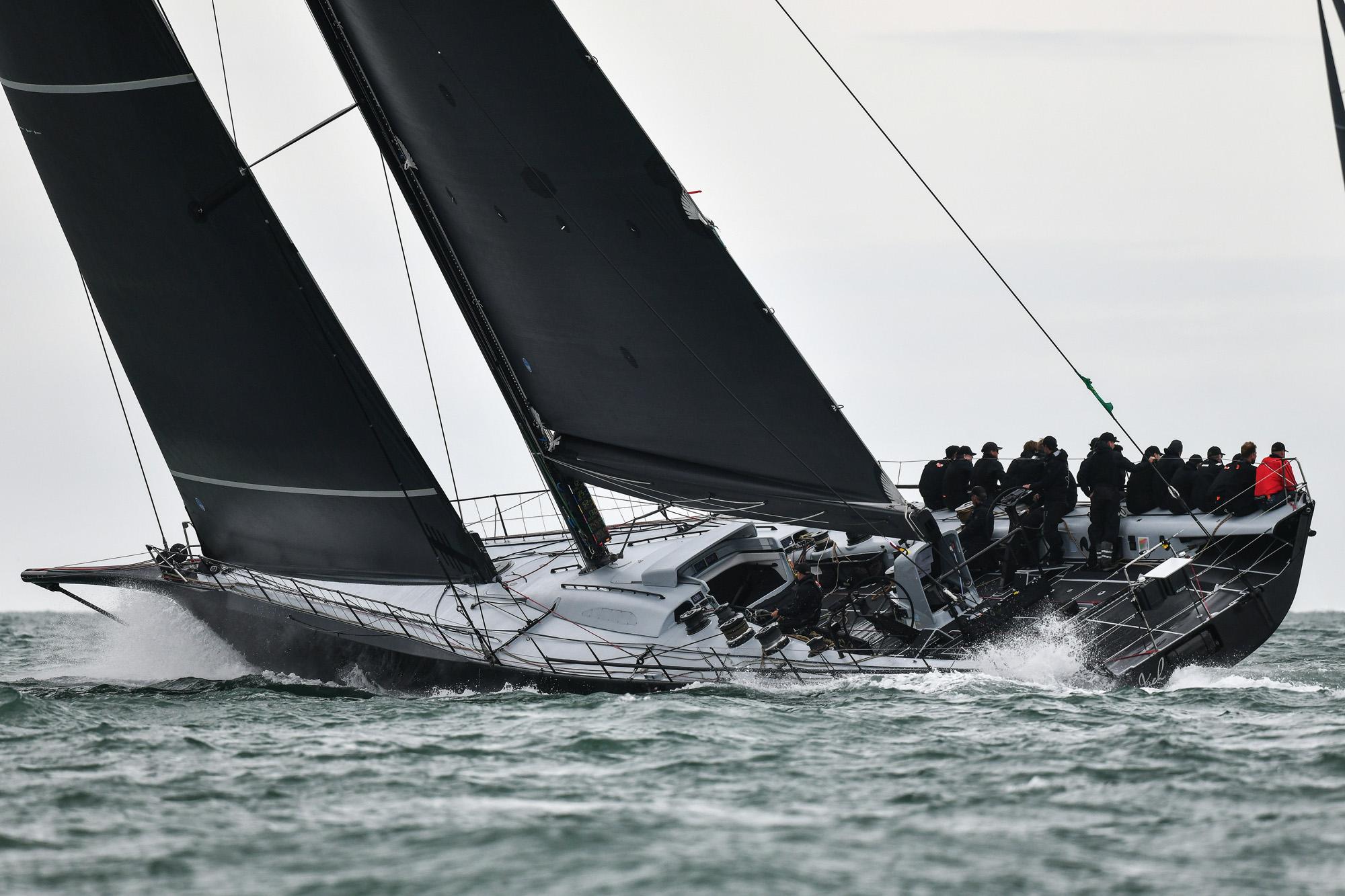 Black Jack stays close to the competition © James Tomlinson/RORC
Black Jack stays close to the competition © James Tomlinson/RORC
On board Black Jack 100 there was scarcely a moment to look up at the Fastnet Rock as it was all hands on deck for multiple sail changes. Hours later and skipper Tristan Le Brun was still reeling from such a hectic but enjoyable 20 minutes manoeuvring around the famous lighthouse. “It was a pretty spectacular rounding because it had just got dark and the wind was quite light as we approached the Rock. But in the last five or 10 minutes we had an increase to 20 knots.
“We went through three sail changes in 20 minutes, and everyone was on fire,” said Le Brun. “We were doing boat speed of about 25 knots as we went around the Rock and going parallel to the Traffic Separation Scheme. The whole boat was very loud, very fast and very wet. It was a thrilling moment and I think the owner had stars in his eyes.”
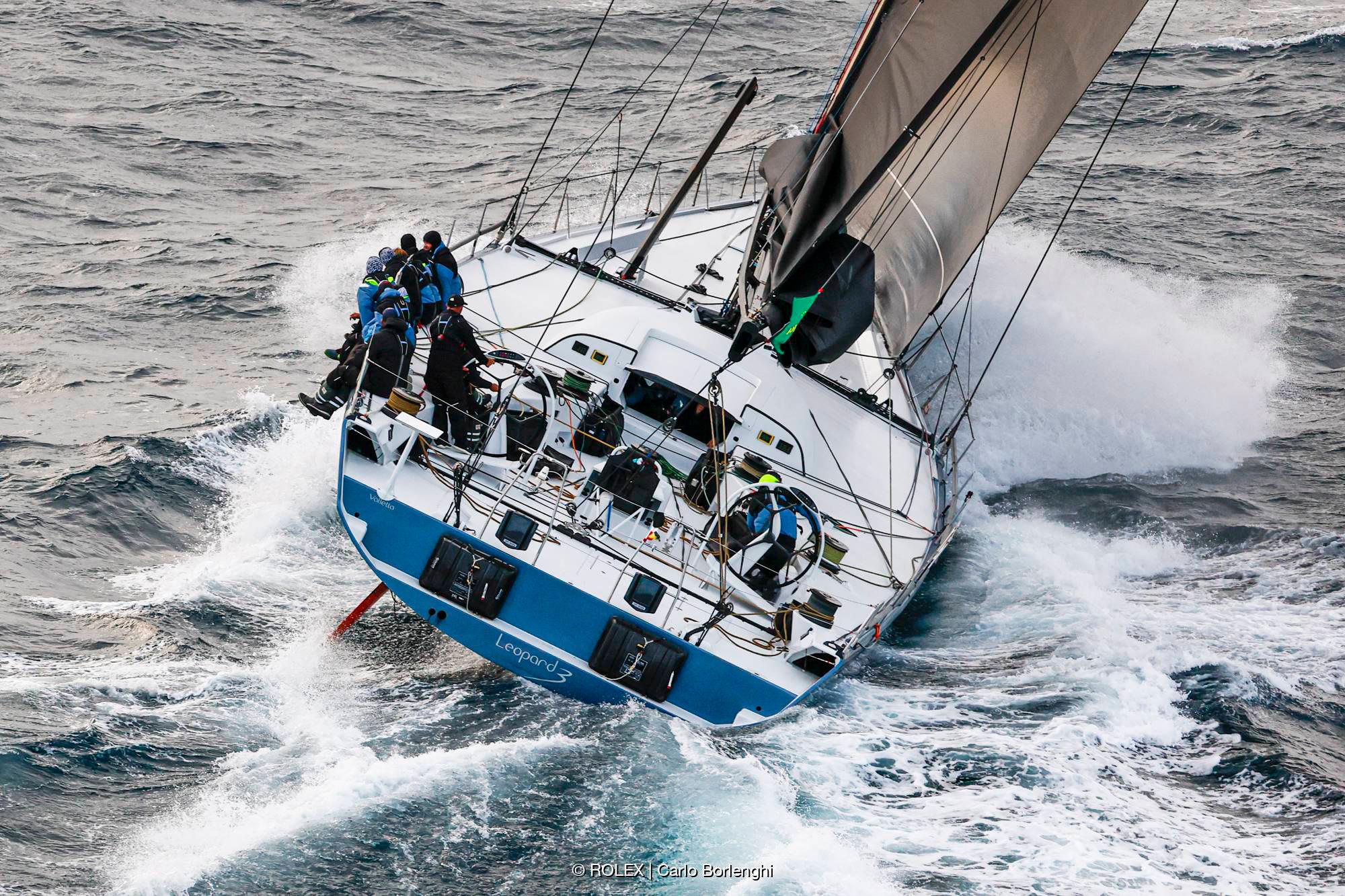 New hands and old hands on Leopard 3 © ROLEX/Carlo Borlenghi
New hands and old hands on Leopard 3 © ROLEX/Carlo Borlenghi
For Spanish offshore veteran Guillermo Altadill, his rock rounding on board Leopard 3 was one of the gentler ones that he could recall. “This is probably my 11th or 12th Fastnet, some number like that, but life is quiet out here, pretty light winds. It was dark when we went round the Rock, so we could only see the lighthouse. We were very close to Black Jack and four or five miles behind Scallywag. It was nice because we've been sailing for the last 20 hours together with only a small separation.
“But now we’re going downwind towards the finish, you can see the differences opening up. Upwind we can hold speed with the other two, but downwind they are probably 10 per cent faster than us.”
The speed of the fastest boats in this race has increased enormously since Altadill embarked on his first Rolex Fastnet Race back in the late 80s. “The boats are so much faster now and probably even easier to sail because the faster you go, the easier everything gets,” says the 63-year-old who’s providing navigation back-up to Will Best. “The navigation has changed completely. Back in the day there was a lot of guess work, but now the weather information is so accurate, which means you can play the wind shifts much more easily.”
This is perhaps why the three boats have stuck to each other so closely in the race up to the Fastnet Rock, says Le Brun on Black Jack 100. “We have played our options in such a way as to stay close to our competition all the time,” he explained. “The level of the navigators on these boats is very high, so it's very unlikely that one of us is going to make a big navigation mistake. So that's why the three boards are sailing in the same area - because we are travelling at a similar speed in the same weather system. We are aware that taking a big option will be a very big risk. So that's why nobody does that.”
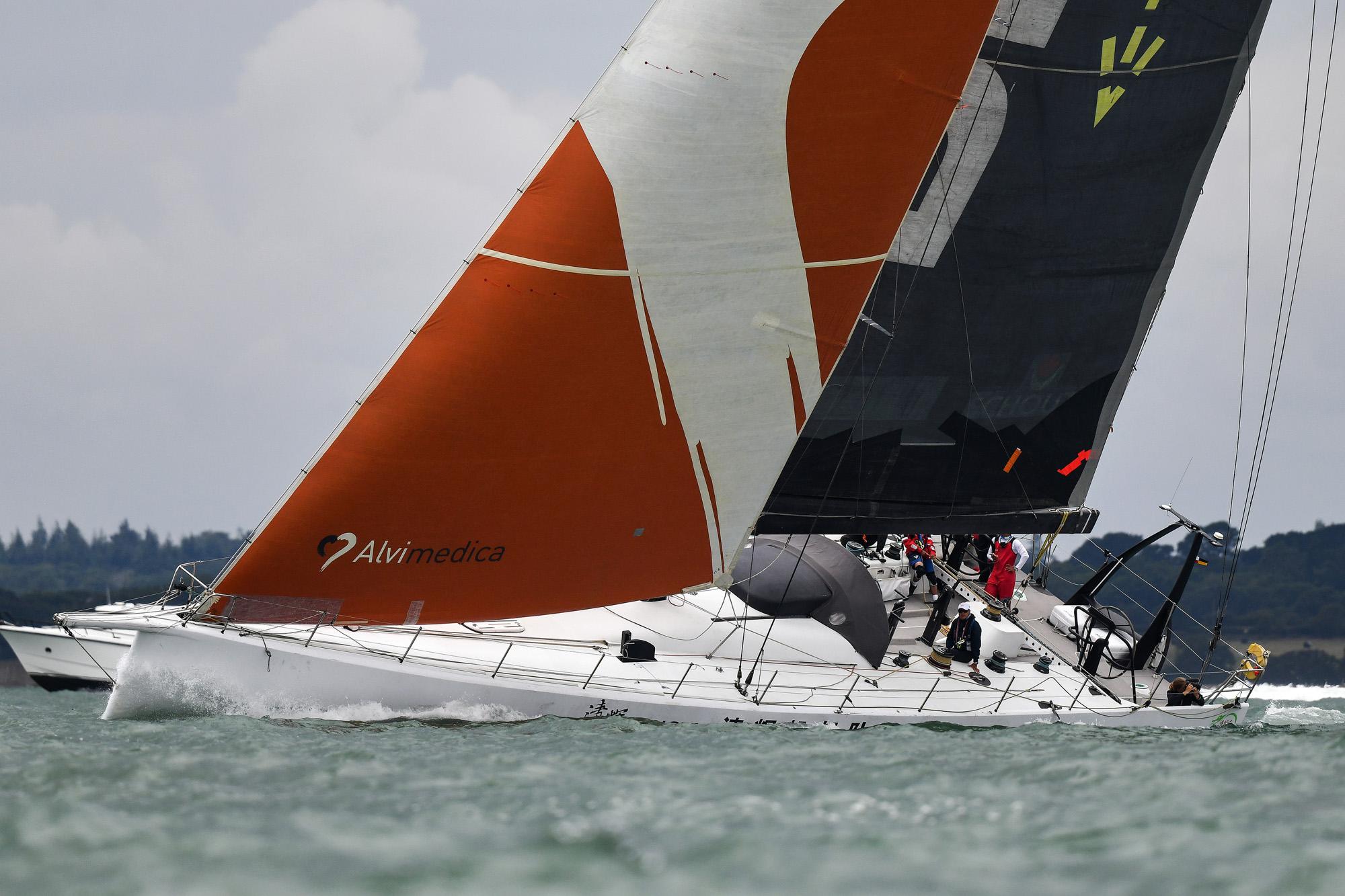 Volvo Open 70 Green Dragon © James Tomlinson/RORC
Volvo Open 70 Green Dragon © James Tomlinson/RORC
Further back, Olympic gold medallist from London 2012 in the women’s singlehanded dinghy, China’s Lijia ‘Lily’ Xu was enjoying her first Rolex Fastnet Race on board Green Dragon, a Volvo Open 70 from the 2008/09 Volvo Ocean Race. “It’s good to be on a mighty VO70 but the sails are very old and we don’t push too hard. But it is very good considering it’s my first Fastnet. The wind is light to medium, it’s warm and summery, but I definitely want to come back for more tough conditions.”
So begins Lily’s foray into the Fastnet, but for Peter Isler on Pyewacket 70 it’s more like the closing of a chapter. “This is our team's last race on Pyewacket,” he said. “We've had a great run with the boat over the past few years and Roy [Disney, the owner] and team manager Robbie Haines have put together a great sailing team. But Roy has decided that it’s time to put one of his 70-footers on the market. We just sailed the ‘sled’ Pyewacket in the Transpac Race a couple of weeks ago.”
Isler will enjoy the race all the way to the finish. “There have already been a handful of lead changes - and playing the chess game of which way to go is always more interesting when you have someone to measure against. We are hoping to pull a rabbit out of our hats on this leg to Cherbourg.”
Currently it looks like Black Jack 100 will lead the Maxis across the finish with navigator Max Deckers estimating an arrival of around 23:00 hours. In the past two editions into Cherbourg, the Alderney Race has stood in the way of the fleet as the last major obstacle before the finish in Cherbourg. A strait that runs between the island of Alderney and Cap de la Hague, a cape at the northwestern tip of the Cotentin Peninsula, the Alderney Race can see currents ripping through as strong as a boat-stopping eight knots. But Deckers didn’t seem too concerned. “It looks like the current will be flowing with us when we get there, but even if it was against us it would create more apparent wind for us.”
IRC Zero: Aussie rules, but Varuna 6 and Palanad 4 close the gap
In the battle for IRC Zero, pre-race favourite Varuna 6 is closing the gap on current leader Whisper from Australia. Varuna’s experienced German owner Jens Kellinghusen has assembled a hot crew on board his Ker 56, including Volvo Ocean Race veteran, Spain’s Roberto ‘Chuny’ Bermudez de Castro.
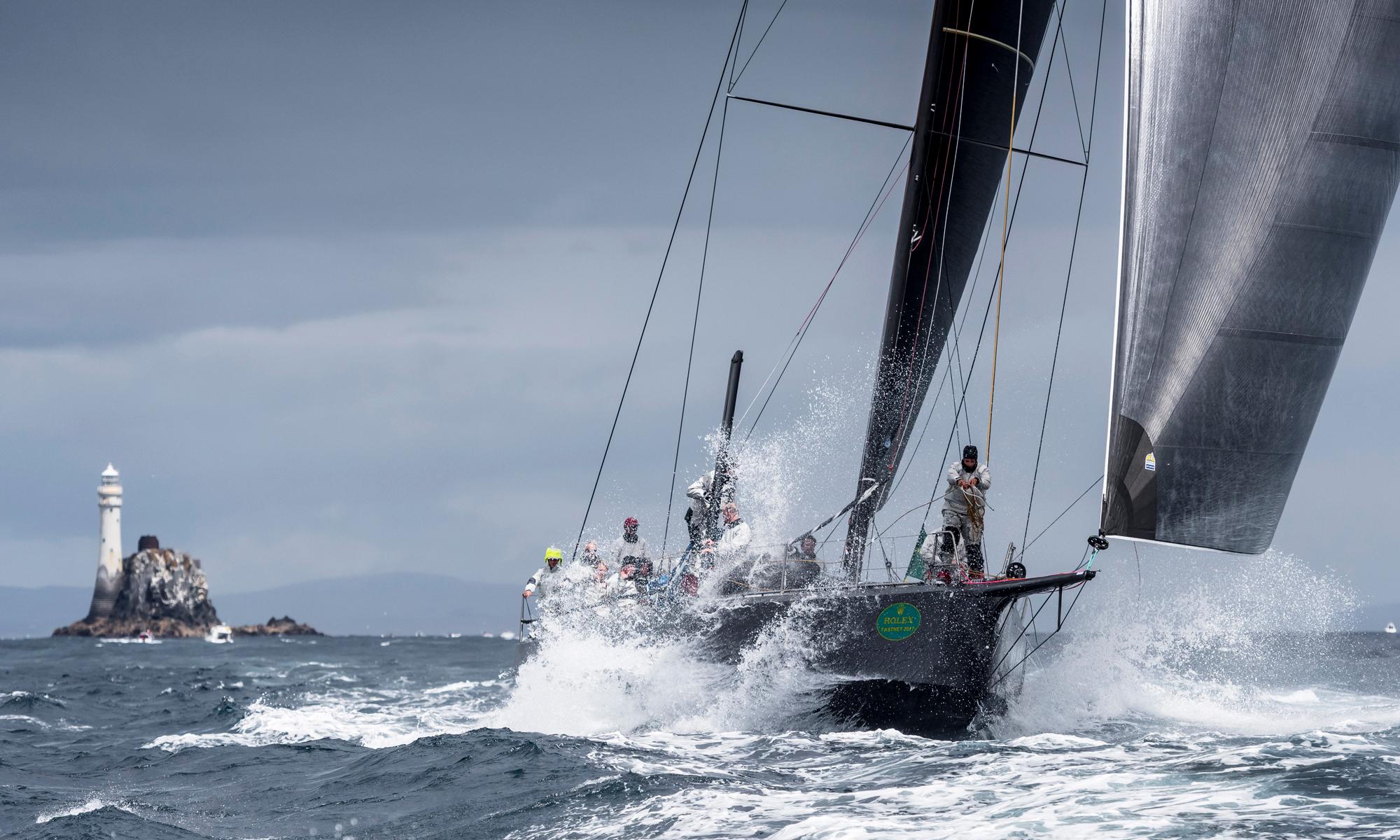 Varuna heads downwind after the Fastnet Rock © ROLEX/Kurt Arrigo
Varuna heads downwind after the Fastnet Rock © ROLEX/Kurt Arrigo
Now that they’ve turned past the Fastnet Rock and downwind back towards the English Channel, will the Germans be able to spinnaker their way closer to the Australians on Whisper. Also faring well, despite an eleventh hour change of skipper is another German boat, the 52ft Rafale. Malte Paesler is gutted to be missing out on the 695-mile adventure with his teammates. “I was supposed to be the skipper on Rafale but unfortunately I became sick on Friday and didn’t recover until the start. Klaas [Höpcke] stepped up and took over my position.”
Rafale’s owner Henri de Bokay reported from the race: “All good on board Rafale. It was an exciting start coming out the Solent. Interesting upwind, a little soft at times, plenty of good company. We enjoyed our Sunday roast - just kidding! Missing our skipper Malte, who sadly fell sick on the eve of the start. It gave us an opportunity to invite Bouwe Van Der Weiden, former Rafale crew member to wear his team’s colours around the Rock. Enjoying the race. Happy to be sailing downwind in the sun.”
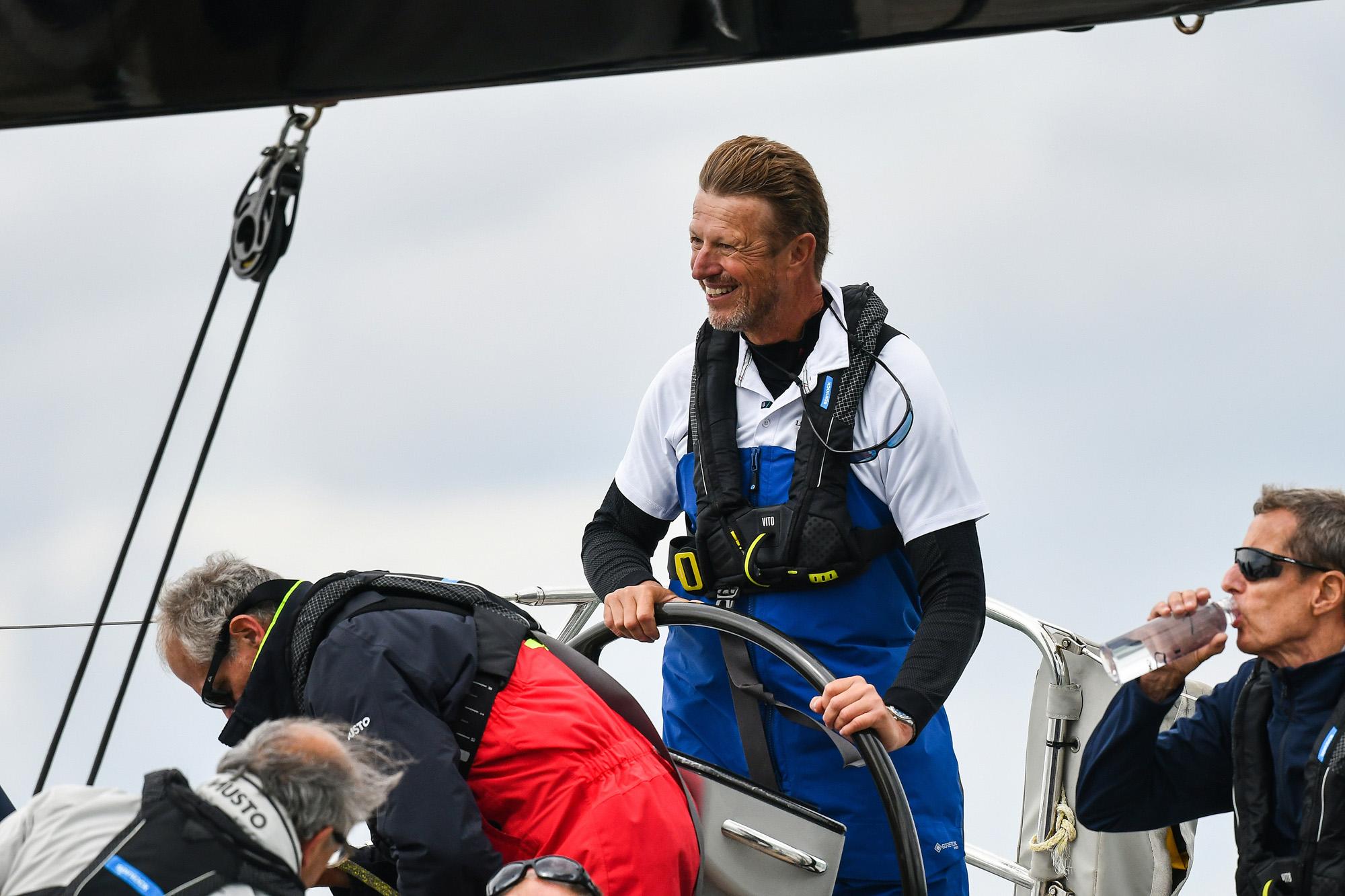 Jean-Pierre Dick relishes life onboard La Loevie © James Tomlinson/RORC
Jean-Pierre Dick relishes life onboard La Loevie © James Tomlinson/RORC
So is Jean-Pierre Dick enjoying the sunny conditions. A veteran of many offshore and round-the-world races, and winner of some, the Frenchman is savouring a more comfortable life on board the relatively luxurious Swan 76, La Loévie. “I’ve done quite a few rough Fastnets. I remember sailing with Bernard Stamm in 2005, and we were fighting through some big storms, so it’s nice to be able to enjoy the beautiful scenery this time, and to see the Rock in daylight. It’s a pleasure for everybody on board.”
One boat that should prove quick on the downwind return to Cherbourg is Antoine Magré’s Palanad 4. This is an ultra-lightweight, scow-bowed offshore 50 footer designed by Sam Manuard, which Magré says combines lessons learned from his old Class40 with those from the offshore TP52s. It’s a case of so-far-so-good for a boat that had barely got wet before the race start out of Cowes on Saturday morning.
“It's funny to think that a week ago before the start, we were just putting her in the water,” laughs Magré. “And then we only had one training day because of the heavy wind in Brittany last week. So we’re very, very happy. Obviously, it's good to see her strengths. Also good to see the weaker spots. And there'll be plenty of feedback for the sailmaker as well.”
A perceived weak spot with the design was in lighter airs, but, “Sam [Manuard] is feeling better now. He was quite worried at the start because of the light airs. And now we've confirmed that she's a bit tougher to get through below 10 knots. She's shown massive potential.”
Now there might be an opportunity to lean into the boat’s expected strengths, downwind conditions with a breezier forecast. “Sunday morning was a bit difficult with the light of wind and the sea state,” sighed Magré. “The whole way up to the Rock was a bit tedious. But we were kind of expecting it. The motivation was that we were going to have a bit more wind and downwind for the way back. So we’re happy we're there. I think we’re looking at an average windspeed of 15 to 18 knots, with the odd gust up to 20, so a bit more than what was forecast, although we're hoping for a bit more.”
As to whether Palanad 4 might overtake Whisper on corrected time: “I don't know yet. I know we'll do our best. We'll do what we can and then we'll count our coins at the end of the race.”
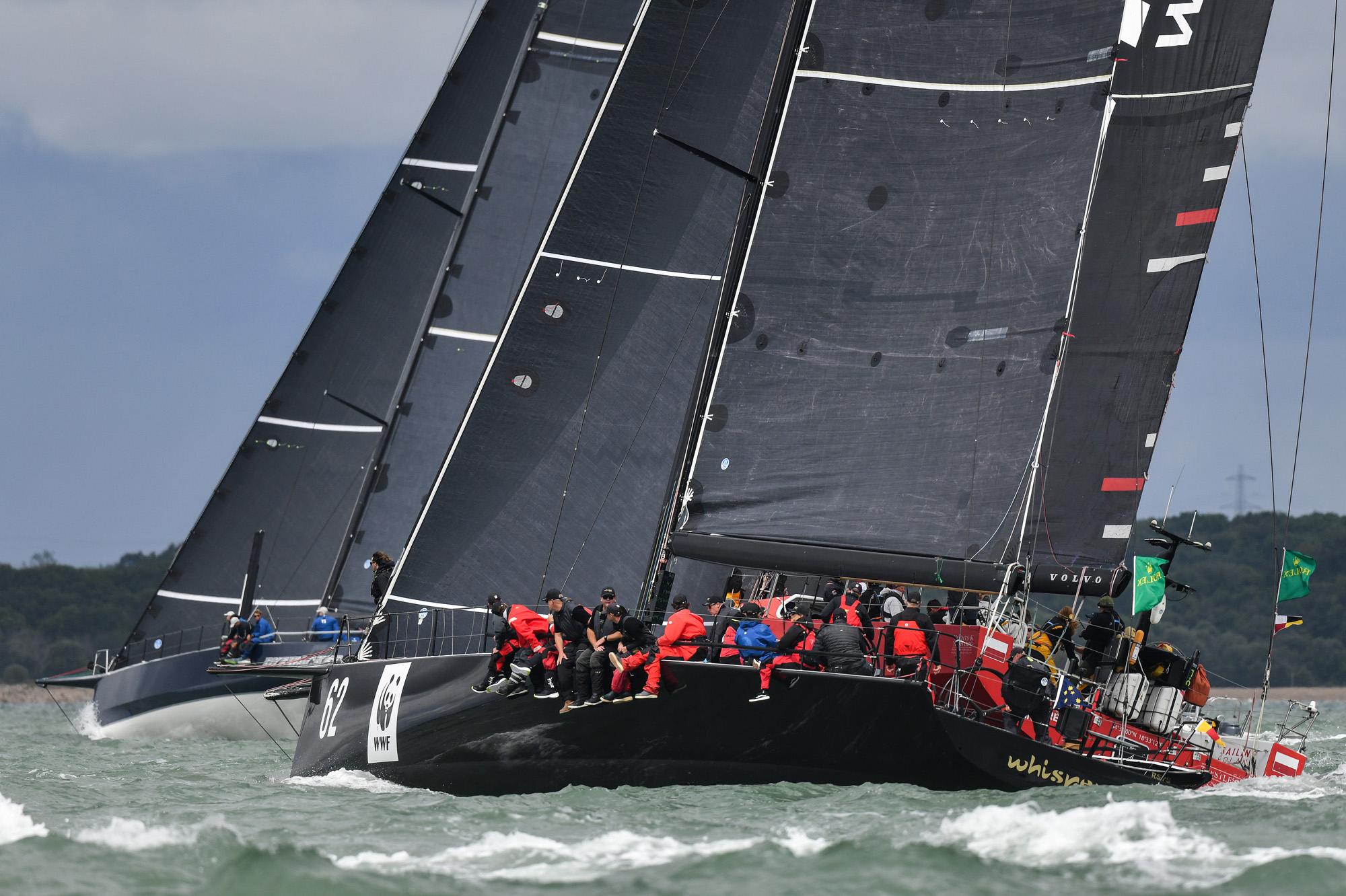 First Rolex Fastnet Race looks good for owner of Whisper, David Griffith © James Tomlinson/RORC
First Rolex Fastnet Race looks good for owner of Whisper, David Griffith © James Tomlinson/RORC
On board Whisper, the Judel/ Vrolijk 62 from Australia, the mood remains upbeat. For owner and skipper David Griffith, his first time around Fastnet Rock could hardly have gone better. Rounding at 0530 hours delivered the perfect light to enjoy the moment. “It was sunrise, steady breeze and it was pretty much out of the tourist brochure,” said Griffith. “We were going around close with some of the trimarans and one of them must have caught a lobster pot or something. They were head to wind with their headsail furled, so we went past them before they got going again.
“Now we’re hooning along at up to 16 knots, which is nice. We’ve been doing 11s, but it’s starting to fill in. We’re watching what the TP52 are doing ahead of us and they seem to be going hard left so they’re obviously looking for some good right-hand breeze to take them away.”
Tactician Peter ‘Billy’ Merrington described the similarities and differences between Whisper and the TP52s nearby. “We have some similar sails and do similar angles to them in some conditions, but we close to 11 tons and they’re more like seven, so they’re a big skiff really.”
Merrington and his fellow Aussies are enjoying sailing up in the northern hemisphere. “When we’re sailing on the east coast of New South Wales you’re used to seeing the sunrise come up over the sea. So it was really nice to see the sunrise coming up over the land. That was pretty cool.
“And from the weather perspective, I was just discussing with Clare [Costanzo, the navigator] the other day and we were just getting our head around seeing the weather systems move in the opposite direction compared with what we see back home. It takes a little bit of getting used to but, you know, we're getting onto that pretty quickly.” Even their IRC Zero rivals would have to agree.
By Andy Rice
